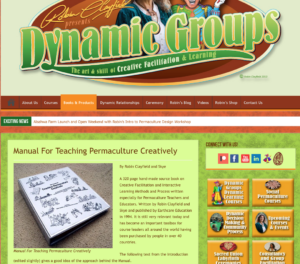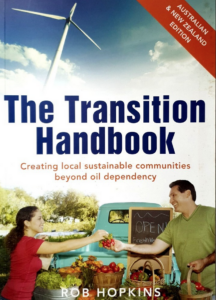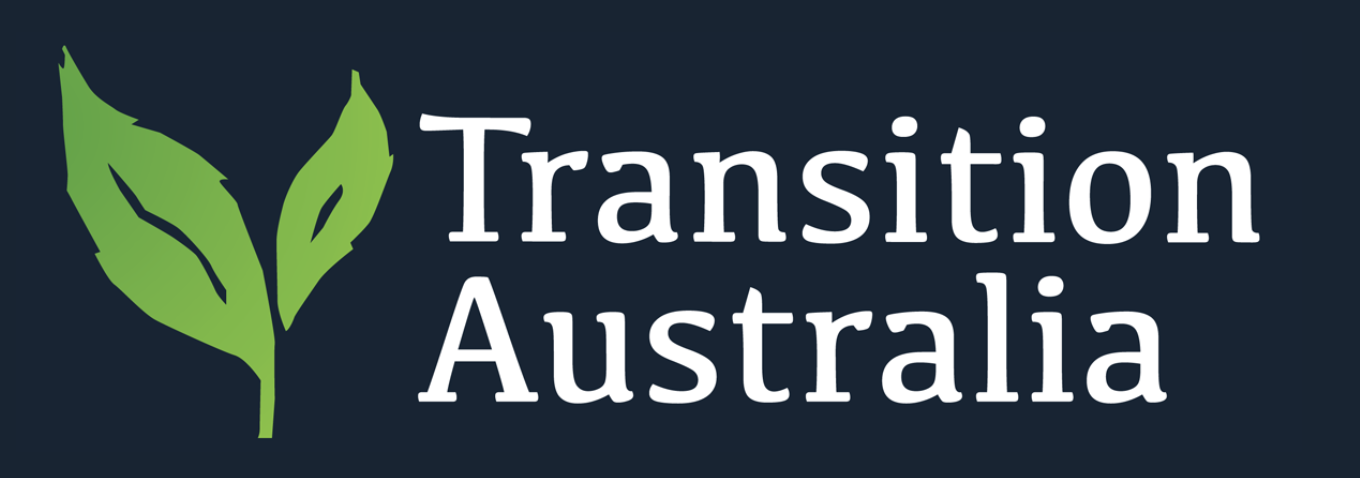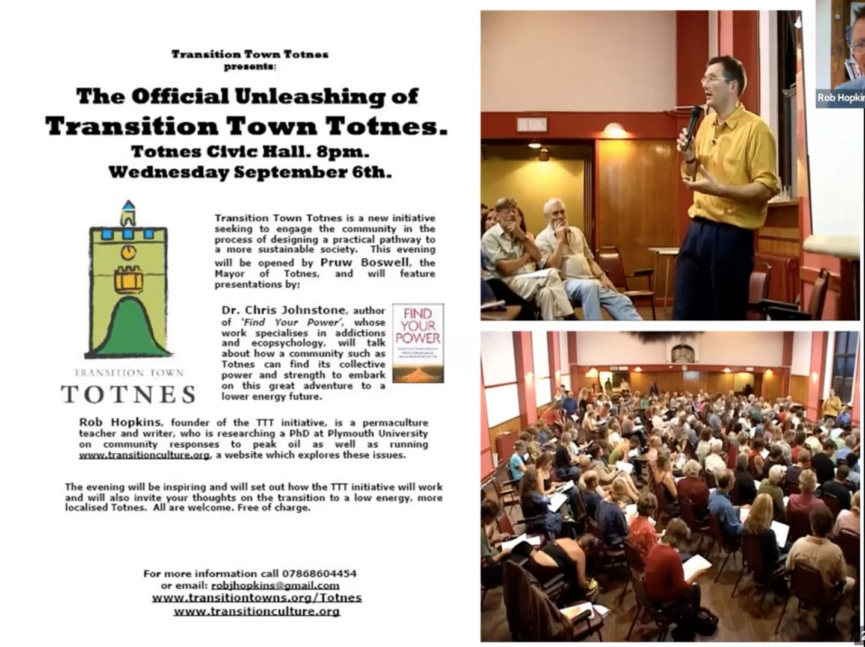In 2006 Rob Hopkins co-founded the Transition movement. What is the connection with Permaculture?
Here is what I have gleaned from various podcasts, articles and videos: As a 22-year-old Rob’s interest in Buddhism led him to travel for a year in India, Tibet and Pakistan. He traveled with an “Aussie bloke”, Chris, who kept on talking about permaculture. Rob didn’t know what permaculture was. On his return to the UK a friend gave Rob a copy of Bill Mollison’s Permaculture Design Manual, which struck him as a manual for Earth Repair- an inspiring concept. “Permaculture rewired my brain” he said “where you shift from what there is, to what is possible”. He says it “rewires the brain to think in systems theory” and it “gave me my possibilities glasses”: he began “to see lawns as gardens, walls as potential growing spaces, all the roofs as potential solar power generating places…”
Rob says he’s glad he had encountered the permaculture way of thinking before he went to University and did a Sustainability degree “otherwise it would have been a massively depressing way to spend three years. But I was the one in the clouds going oh oh maybe we could … you know … bring solutions into all of that” [quote from Kadoorie Earth Programme video].
In 1996 Rob moved to Ireland with his young family to establish an Eco-village project and build cob houses. At Kinsale College of Further Education he pioneered a one-year practical sustainability course “like an expanded PDC (Permaculture Design Certificate) with lots of practical elements, projects, trips….”.
Rob wrote (in his article From Tiny Acorns: celebrating 21 years of the Kinsale permaculture course):

Dynamic Groups website: Manual for teaching permaculture creatively
“Before the course started, I got a copy of a book called ‘The Manual for Teaching Permaculture Creatively’, by Robin Clayfield and Skye, and did a course of the same name, and learned a whole new approach to teaching, based on games and play and different ways of learning. I was given the freedom to design the permaculture course I would love to have done. If you laugh and get to play with others while you’re learning, you actually learn more with a brain awash with endorphins, as it turns out. It also turns out that you retain far more information when you do as well as listen. Who knew?”
The course was always booked out, and after some years Rob expanded it to become a two-year course. In 2004 Rob read David Holmgren’s book “Permaculture: Principles & Pathways Beyond Sustainability” which “put permaculture right back in the middle of the solution to action on climate change.” Holmgren’s book said permaculture design principles are the principles we need in order to create a low-carbon future, they are the design principles for the 21st century in that context. “It was a real light bulb moment for me”, says Rob.
That same year Rob Hopkins said to his 2nd year students “Your main project for the rest of this year is to consider if Kinsale over the next 20 years were to make the journey from where it is now, completely oil-dependent for everybody, to a place where that wasn’t the case anymore, how would it do that, how would you tell that story, what would it be like, and can you design what that would look like year by year. So I gave different combinations of students different aspects: you three are doing food, you guys tourism, you, education and so on…. At the end of the year all handed in their assignments and I marked them and I looked at them all and I thought this is amazing… so we put it all together into a little book and printed 500 copies…” (quoted verbatim from Morag Gamble interview 10.55 – 13.48)
They called it the Kinsale Energy Descent Action Plan and made copies available at a conference called Refuelling the Future. Guest speaker Richard Heinberg loved it. He said “that is the missing piece we’ve all been waiting for”. He took copies back to the USA. Someone from Australia ordered 100 copies. Some of the students followed up by forming action groups on Energy, Food, Transport etc and they came up with the term “Transition Town”. They obtained funding from the Council to start implementing the plan. Significantly, they put the Kinsale Energy Descent Action Plan online and had several thousand downloads.
The following year Rob Hopkins and his family moved to Totnes in Devon, UK and connected with Naresh Giangrande, Sophy Banks and others to go through a similar process envisaging Totnes as no longer oil-dependent. Thus began the Transition Towns movement. Rob says “We formally ‘unleashed’ Transition Town Totnes in September 2006 and within months, interest from around the world in replicating what we were doing became so overwhelming that we had to create a new organisation called Transition Network to support it.”
So the Kinsale Energy Descent Action Plan created by Rob Hopkins’ permaculture students became the inspiration for the fundamental approach of transition groups everywhere: to envision a future no longer dependent on fossil fuels and then work together to create that future.
Rob Hopkins says: That sense of playfulness, self-organisation, trust and care that was designed into the DNA of the Practical Sustainability course is now also in the DNA of the Transition movement.
Now, in 2025, Rob Hopkins is still focused on the power of imagination to create the future we wish to see. His new book ‘How to Fall in Love with the Future’ will be published on 17 June. See https://www.robhopkins.net/
Read:
Online article: From Tiny Acorns: celebrating 21 years of the Kinsale permaculture course. by Rob Hopkins. This article was written as a speech for the event called ‘21 Years of Permaculture at Kinsale College‘ on May 28th 2022, a celebration of “21 years of permaculture, practical sustainability and environmental living”.

The Transition Handbook
Online article: Rob Hopkins, Transition and the Power of Just Doing Stuff By Tracy L. Barnett August 2015
Online article: Transition Town: How a small campus in Kinsale, Ireland sparked a global low-carbon movement, Nicole Olweean, January 2024
The Transition Handbook by Rob Hopkins. Australia/New Zealand edition Finch publishing 2009
Online: https://www.resilience.org/stories/2006-01-17/kinsale-council-supports-transition-town-venture/
View and/or listen:
YOUTUBE (55 min.) (2020)
“Imagining a Resilient Future. Morag Gamble in conversation with Rob Hopkins”
YOUTUBE (1 hr 29 min.) (2022)
In this Kadoorie Earth Programme video/talk Rob shares with us his journey from being a permaculture teacher in Ireland to founding the Transition movement, and then to where his work and his thinking are taking him now. He tells stories of community-led change from around the world, explores the Transition model and how it came about, and then shares the work he is doing at the moment with its focus on the cultivation of more imaginative communities and the creation of an ‘imagination infrastructure’.
Mary Stringer
May 2025

